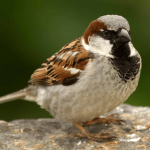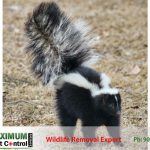
Dealing with Unwanted Wildlife Visitors? Learn About the 4 Common Intruders We Encounter
Are you tired of unwelcome wildlife visitors making themselves at home in your space? From mischievous raccoon’s to sneaky squirrels, pesky bats to stinky skunks, we’re here to help you navigate the world of common intruders. Let’s dive into the fascinating habits and characteristics of these critters so you can effectively deal with their presence.
Wildlife pests can quickly turn your home or business into their own personal playground if you’re not careful. From destructive raccoon’s tearing up attics to skunks digging up yards and creating foul odors, these uninvited house guests bring nothing but headaches.
The four most common critters professional wildlife control experts deal with are raccoon’s, squirrels, skunks, and bats. Each of these persistent pests has its own clever methods of gaining entry and taking over spaces. In this blog, we’ll dive into the troublesome behaviours of each species and the risks they pose to properties.
Keep reading to learn how to identify signs of wildlife infestations and what you can do to prevent these nuisance animals from moving in.
The Importance of Addressing Wildlife Intruders
Wildlife pests can wreak havoc on homes and properties if left unchecked. Critters like raccoon’s, opossums, and squirrels may seem harmless, but their presence poses serious risks.
These uninvited guests can cause significant structural damage by gnawing through wood, drywall, and even electrical wiring while seeking shelter or food sources inside. Their feces and urine also create unsanitary living conditions and foul odors. What’s more, some carries diseases transmittable to humans and pets. From property devaluation to health hazards, ignoring these problems rarely ends well.
Common Points of Entry for Wildlife Pests
Wildlife pests are resourceful in finding ways into homes and buildings. Uncovering and sealing up their common entry points is crucial for preventing infestations.
Openings and gaps around roof-lines, vents, chimneys, and pipes provide easy access for critters. Raccoon’s and squirrels need only a few inches to squeeze through. Spaces under porches, sheds, and decks also serve as open invitations. Even seemingly insignificant cracks in foundations, siding, or utility lines can let in smaller rodents like mice and rats. Regularly inspecting the exterior and addressing vulnerabilities deters these unwanted house-guests.
Windows, pet doors, and other openings on ground levels also let wildlife come waltzing in. Firewood stacked along the home’s perimeter acts like a welcome mat too. Denying pests easy entry goes a long way toward avoiding the headaches of dealing with an infestation after they’ve settled in.
Squirrels: Acrobatic Attic Wildlife Invaders
Don’t underestimate the agility and determination of squirrels when it comes to breaching homes. These furry acrobats are masters at scaling heights and squeezing through the smallest gaps near roof-lines to access attic spaces. Once inside, they can gnaw on wiring, insulation, and woodwork to create cozy nests and food caches, causing costly damage. Their constant scampering and noisy bickering signal an active infestation.
Humane Removal Techniques
When it comes to humane wildlife removal techniques, exclusion is key. This involves sealing up entry points and installing one-way doors that allow pests to exit but not re-enter. Deterrents like bright lights or noisemakers can encourage animals to leave on their own too. Trapping and relocating should always be a last resort carried out by licensed professionals following ethical protocols. Removing food sources, closing off denning areas, and making your property less appealing overall through deterrence is the most humane and effective approach.
Raccoon’s: Clever and Destructive Critters
Raccoon’s are among the cleverest and destructive wildlife pests around. These masked bandits have incredibly dextrous hands and an insatiable curiosity that helps them break into seemingly secure areas.
Their powerful forelimbs and non-stop scratching allow raccoons to rip apart vents, shingles, siding and more to gain entry into attics, chimneys and crawl spaces. Once inside, they create massive, smelly messes with their incessant denning, defecating and foraging for food. Beyond making a property unlivable, raccoons also pose risks of physical aggression if cornered and potential disease transmission through parasites. Promptly removing and preventing raccoon infestations is essential for protecting homes and families.
These headstrong critters are also notoriously difficult to get rid of through deterrents or basic exclusion methods alone. Their intelligence and persistence mean professional wildlife removal is often necessary to successfully evict raccoons and block re-entry for good. A minor raccoon problem can escalate into a major fiasco without an integrated, strategic approach.
Skunks: Smelly Backyard Nuisances
Skunks may seem like harmless backyard visitors, but they can quickly become big stinky problems if they take up residence. These striped scavengers dig holes and burrows under sheds, porches and decks seeking denning spots to birth their litters.
Their relentless digging and roaming also tears up yards, gardens and lawns while they hunt for grubs, insects and small rodents. Skunks are bold enough to raid garbage cans and compost piles too, creating foul-smelling messes. Of course, their most notorious defense is releasing an overwhelmingly potent musky spray that lingers for weeks and carries serious health risks if inhaled at close range. Evicting skunks requires protective gear and strategic exclusion efforts.
Skunk-Proofing Your Property
While relatively mild-mannered when not startled, skunks can become aggressive during mating season or when guarding food sources. Households with dogs and outdoor pets face increased risks of unpleasant skunk encounters and odor bombings. Preventing denning under structures in the first place through proper fencing and exclusion is far preferable to dealing with an established skunk family taking over the yard.
Bats: Winged Wonders or Attic Pests?
Bats play a vital role in ecosystems as insect-eaters and plant pollinators, but they can become nuisance pests when roosting in homes. These flying mammals often squeeze through incredibly small openings to take up residence in attics, chimneys, and wall voids.
Potential Health Risks
An attic bat infestation brings a whole host of issues beyond just the creepy factor. Their droppings and urine create horrible odors and stains, while also potentially spreading fungal diseases. Bats also make a ruckus with their constant squeaking and scratching. Perhaps worst of all, their guano accumulations can attract other pests like insects and rodents, compounding the problem. Safely evicting bats requires care since they are protected species.
Safe Bat Exclusion Methods
Bats typically only become nuisance pests when man-made structures provide ideal roosting spots close to their normal habitats and feeding areas. Exclusion, better known as “bat-proofing” using sealants and meshes, is the best solution once bats have been properly excluded. Taking preventative measures is far easier than dealing with an established bat colony that’s already moved in.
When to Call the Experts
While some wildlife intrusions may seem minor at first, attempting self-removal often leads to bigger headaches down the road. It’s best to call in professional wildlife control experts as soon as you detect signs of pests like nesting materials, droppings, or strange noises. Trying ineffective home remedies usually just allows an infestation to escalate and spread further.
Pros have the proper training, tools, and legal permits for safe, effective removal and exclusion. They can also give assessment and fix potential entry points to prevent future problems. Don’t risk potential property damage or dangerous encounters – outsmart persistent wildlife by enlisting experts from the start.




